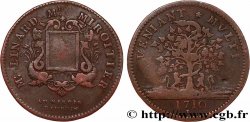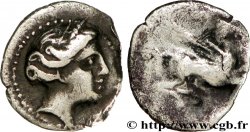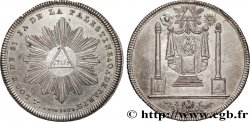You must signin and be an approved bidder to bid, LOGIN TO BID. Accounts are subject to approval and the approval process takes place within 48 hours. Do not wait until the day a sale closes to register. Clicking on « bid » constitutes acceptance of the terms of use of cgb.fr private e-auctions.
Bids must be placed in whole Euro amounts only. The sale will start closing at the time stated on the item description; any bids received at the site after the closing time will not be executed. Transmission times may vary and bids could be rejected if you wait until the last second. For further information ckeck the E-auctions F.A.Q.
NO BUYER'S FEE.
NO BUYER'S FEE.
| Estimate : | 220 € |
| Price : | 106 € |
| Maximum bid : | 111 € |
| End of the sale : | 03 April 2023 19:14:00 |
| bidders : | 7 bidders |
Type : CORPORATIONS : Traiteurs
Date: 1719
Metal : silver
Diameter : 27 mm
Rarity : R2
Catalogue references :
Obverse
Obverse legend : LUD. XV. REX CHRISTIANISS.
Obverse description : Buste à droite de Louis XV signé DUVIV. [n° 308a].
Obverse translation : Louis XV, roi très chrétien.
Reverse
Reverse legend : MATER. CHRISTI ; À L'EXERGUE : COMMUNAUTE. DES. ME. TRAITEURS. 1719 (9 À L'ENVERS).
Reverse description : La Vierge debout de face, tenant dans ses bras l'enfant Jésus.
Reverse translation : La mère du Christ.
Commentary
Sous l'Ancien régime, le traiteur exerce une profession plus respectable que celle de tavernier, qui ne vendait que du vin, de celle du rôtisseur ou celle de cabaretier qui servait vin et repas complets, ce dernier parvenant toutefois à attirer toutes les couches de société. Les marchands de vin traiteurs, spécialisés à l'origine dans les noces et les banquets, supplantent au XVIIIe siècle tavernier, rôtisseur et cabaretier lorsqu'ils se mettent aussi à préparer les repas pour des clients fidèles ou de passage, avant d'être à leur tour supplantés par les restaurateurs à la fin du XVIIIe. Voir la fiche http://fr.wikipedia.org/wiki/Traiteur.








 Report a mistake
Report a mistake Print the page
Print the page Share my selection
Share my selection Ask a question
Ask a question Consign / sell
Consign / sell
 Full data
Full data















